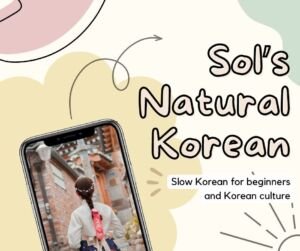로, 으로 grammar
Hello, everyone!
Today, we will learn about the very versatile grammar point 으로/로. This point can help us express phrases like “by bus,” “please tell me in Korean,” and “I work as an engineer.”
There are many usages of 으로/로, and I’ll cover them one by one.
Now, let’s conquer the concept of (으)로 together!
I will explain each point step by step to facilitate understanding.
So just follow along with me!
Part 1,
Let’s grasp the concept of grammar
(으)로: To indicate the tool, device, method, or material with which something is carried out.
Let’s take a closer look how to form this!
When a noun ends in a vowel: 로
When a noun ends in a batchim(final consonant): 으로
First usage is using (으)로 to indicate the tool, device, method, or material with which something is carried out.
Examples 😊
Write with a pen. 펜으로 적다
Go to the store by car. 차로 가다
Travel by train. 기차로 여행하다
Make a house out of wood. 나무로 만들다
Please send this file by email. (Please send this file, using email) 이 파일은 이메일로 보내 주세요.
I study Korean using an iPad. 아이패드로 한국어 공부해요.
I take Korean classes using a laptop. 노트북으로 한국어 수업 들어요.
Ending in “ㄹ” batchim is an exception, we directly add “로” after a noun.
Cut with a knife. 칼로 자르다.
Communicate by mail. 메일로 소통하다.
Fix it with glue. 풀로 고치다.
In this same respect, ~(으)로 can also be used to indicate the language in which something is spoken.
Here, the language functions as the “tool” used for communication.
Please speak in Korean. 한국어로 해 주세요.
I will say that in English. 영어로 할게요.
How can you say that word in Korean? 한국어로 그 단어 어떻게 말해요?
(2). (으)로 is also used to indicate what you ate for a specific meal
I ate egg and sausage for breakfast. 아침으로 계란이랑 소세지 먹었어요.
I usually only ate fruit for lunch. 점심으로 과일만 먹어요.
I didn’t eat anything for dinner. 저녁으로 아무것도 안 먹었어요.
(3). (으)로 can mark the status or identity of a person doing something.
This case –(으)로 is often translated as ‘as’ or ‘for’ (consider something, someone).
I made a debut as a singer last year. 작년에 가수로 데뷔했어요.
I am working as a freelancer. 프리랜서로 일하고 있어요.
I thought of him as a fool. 바보로 생각했어요.
I mistook you for a student. 학생으로 착각했어요.
(4). (으)로 is often added after ~쪽 to form ‘~쪽으로’. The suffix ~쪽 can be added to some nouns and direction words (like above, below, east, west, etc.) to mean ‘in the direction of ___’ or ‘toward ___.’
그쪽 = that way/direction / 위쪽 = upper direction / 사람 쪽 = the direction of the people
ex) 그쪽으로 가세요. Go that way.
위쪽으로 보세요. Look up.
아래쪽으로 보세요. Look down
사람이 많은 쪽으로 가세요. Go toward the direction where there are many people.
You might wonder about the difference between the location marker ‘-에’ and ‘-(으)로’ when meaning ‘to/towards.’ The marker ‘-에’ is used for a location noun that represents a destination, while ‘-(으)로’ indicates direction but doesn’t necessarily imply a destination.
학교에 가요. I go to school. (School is a destination)
학교쪽으로 가요. I head towards the school. (Here, “학교쪽” indicates the direction toward the school, but the destination might not be the school itself.)
Similarly, it is used to Indicate a Path or Passage
문으로 들어가다. Enter through the door.
길로 나가다. Go out onto the street.
(5). (으)로 can mark a cause of something that happens. This case –(으)로 is often translated as ‘from’, ‘due to,’ or ‘for’
사고로 다쳤어요.
I got hurt from an accident.
이 약은 부작용으로 두통이 있을 수 있어요.
This medicine may/can cause headaches as a side effect.
실수로 프로젝트가 지연되었어요.
The project was delayed due to a mistake.
이 문제는 에러로 발생했어요.
This problem occurred due to an error.
이 식당은 김치로 유명해요.
This restaurant is famous for Kimchi.
(it indicates the reason behind the restaurant’s reputation.)
이탈리아는 파스타랑 피자로 유명해요
Italy is famous for pasta and pizza.
There are more uses for 으로, but these are the most commonly used ones! (It’s already quite a few, haha.)
Now, let’s get accustomed to this grammar by forming sentences! 😊
Part 2,
Practice making sentences
1. I built our house out of wood / I want to build my house out of cement.
(build: 짓다 / wood: 나무 / cement: 시멘트)
2. Please don’t speak in Korean, I have to improve my Korean skills. (casually!)
(Don’t~: 지마(ending) / improve: 늘리다 / skill: 실력)
3. Korea is famous for its cherry blossoms in the spring.
(cherry blossom: 벚꽃 / spring: 봄)
4.I made that with my hands / Did you do it with your foot? . (casually!)
(make: 만들다 / hand: 손 / foot: 발)
5. I ate salad for lunch, so I will eat Korean bbq for dinner!.
(lunch: 점심 / dinner: 저녁 / Korean bbq: 삼겹살)
6. Come over to my side. Don’t go over there. (casually!)
(my side: 내쪽/ over there: 그쪽 / Don’t~ : -지마(ending))
7. Please send that gift by delivery.
(send : 보내다/ gift: 선물 / delivery: 택배)
8. That person is famous as a chef in Korea.
(chef: 요리사 or 셰프)
9. I will go to the Je-ju island by boat / We’re going by plane.
(Jeju island: 제주도 / boat: 배 / plane :비행기)
10. I’ve always wanted to work as a software engineer.
(always: 항상 / software engineer: 개발자)
11. Last year, I got hurt from a car accident.
(get hurt: 다치다 / car accident: 교통사고)
12. Come towards the fruit store! You will see my car. (try to say “my car will be visible”)
(fruit: 과일/ store: 가게/ to be visible, to be seen: 보이다)
Thy these on your own first, before checking the answers!
These are the answers:
1. I built our house out of wood / I want to build my house out of cement.
(build: 짓다 / wood: 나무 / cement: 시멘트)
나무로 우리 집(을) 지었어요. / 시멘트로 내 집(을) 짓고 싶어요.
*When referring to materials such as wood or cement, we use the (으)로. Since both “wood” (나무) and “cement” (시멘트) end in a vowel, we add 로! 😁
* 짓다(to build) is a “ㅅ” irregular verb. If you don’t know, please check it out here!
2. Please don’t speak in Korean, I have to improve my Korean skills. (casually!)
(Don’t~: 지마(ending) / improve: 늘리다 / skill: 실력)
한국어로 하지마. 한국어 실력(을) 늘려야 해.
* In Korean, for the word “in,” we use 로, becoming 한국어로. 한국말로 is also commonly used!
(한국어 and 한국말 are synonyms)
* Instead of 늘려야 해, You can say 늘려야 돼 as well! (have to grammar!)
* 지마 is a verb ending used to express “Don’t + verb.” Simply drop the verb ending 다 and add 지마.
– Don’t do it: 하지마 (하다 + 지마)
– Don’t eat it: 먹지마 (먹다 + 지마)
– Don’t sleep: 자지마 (자다 + 지마)
– Don’t read: 읽지마 (읽다 + 지마)
Formally, you can add “요”, 하지마요(please don’t do it). or 하지마세요(more polite!)
– Please don’t go: 가지마요/ 가지마세요
– Please don’t turn off the computer: 컴퓨터(를) 끄지마요 / 끄지마세요 (끄다: to turn off)
– Please don’t park there: 거기에 주차하지마요 / 주차하지마세요 (주차하다 : to park)
(You can say 거기로 or 그쪽에 or 그쪽으로 instead of 거기에)
3. Korea is famous for its cherry blossoms in the spring.
(cherry blossom: 벚꽃 / spring: 봄)
한국은 봄에 벚꽃으로 유명해요.
* famous for : we can use (으)로, since 벚꽃(cherry blossom) ends in a batchim, we will add 으로)
* “in” the spring, to indicate the time, don’t forget to use “에”!
4. I made that with my hands / Did you do it with your foot? (casually!)
(make: 만들다 / hand: 손 / foot: 발)
내 손으로 그거(를) 만들었어요 / 발로 했어요?.
* To express “with” in phrases like “with my hands” and “with your foot,” we use (으)로.
Since 손 (hand) ends in a batchim, we add 으로: 손으로 (with my hands).
발 (foot) ends in “ㄹ,” so we add 로 directly: 발로 (with your foot). (The “ㄹ” exception!)
*발로 했다 is a common Korean expression meaning to do something poorly. It makes sense, right? After all, you can’t do things properly with your foot! However, this phrase is quite casual, so it’s best used with close friends only. 🙂
5. I ate salad for lunch, so I will eat Korean bbq for dinner!.
(lunch: 점심 / dinner: 저녁 / Korean bbq: 삼겹살)
점심으로 샐러드 먹어서, 저녁으로 삼겹살 먹을 거예요.
* To indicate what you ate for a specific meal, we use (으)로. Since 점심 (lunch) and 저녁 (dinner) both end in a batchim, we use 으로.
* To connect two sentences and express “so,” we use the 아/어/해서 grammar.
6. Come over to my side. Don’t go over there.(casually!)
(my side: 내쪽/ over there: 그쪽 / Don’t~ : -지마(ending))
내쪽으로 와. 그쪽으로 가지마!
* To express the direction, we commonly use 쪽 and 으로 together.
* Formally, you can say “내쪽으로 와요,” “그쪽으로 가지마요!”. Or “내 쪽으로 오세요,” “그쪽으로 가지마세요!”(more polite).
7. Please send that gift by delivery.
(send : 보내다/ gift: 선물 / delivery: 택배)
택배로 그 선물 보내주세요.
* To indicate the method by which something is carried out, we can use (으)로. 택배로! (ending in a vowel)
* Ask something politely, we can use (으)세요 grammar.
* There are 택배 and 배달 to express “delivery,” and here is the difference:
택배: Used for courier or parcel delivery services, typically involving professional companies and larger scale logistics.
배달: Used for local delivery services, often related to food and other small items.
8. That person is famous as a chef in Korea.
(chef: 요리사 or 셰프)
그 사람은 한국에서 셰프로 유명해요.
* “As a chef”, we can say 셰프로 or 요리사로 ( I think 셰프 is a bit more common!)
9. I will go to the Je-ju island by boat / We’re going by plane.
(Jeju island: 제주도 / boat: 배 / plane :비행기)
나는 제주도에 배로 갈 거예요 / 우리는 비행기로 갈 거예요
* by + transportation, we can use (으)로! 배 and 비행기 both end in a vowel, we will add “로”
10. I’ve always wanted to work as a software engineer.
(always: 항상 / software engineer: 개발자)
항상 개발자로 일 하고 싶었어요.
* To express the “have wanted” tense in Korean, we can use the simple past tense!
11. Last year, I got hurt from a car accident.
(get hurt: 다치다 / car accident: 교통사고)
작년에 교통사고로 다쳤어요😫
* 교통사고 refers to a “traffic accident” or “car accident” in Korean. It combines 교통, meaning “traffic”, with 사고 , meaning “accident”.
12. Come towards the fruit store! You will see my car. (try to say “my car will be visible”)
(fruit: 과일/ store: 가게/ to be visible, to be seen: 보이다)
과일 가게쪽으로 와요! 내 차가 보일 거예요.
* towards : -쪽으로!
* You can say “과일 가게에 와요.” This indicates that you should come to the fruit store as a destination.
* 보이다 is a commonly used Korean verb meaning “to be seen” or “to appear”. This verb is typically used when talking about visibility or appearance from the observer’s perspective.
– 산이 보여요 : I can see the mountain
– 내가 보여? 응 잘 보여: Can you see me? Yes I can see you well.
– 화면이 보여? : Can you see the screen?
Great job!
You’ve been doing an excellent job—keep up the good work!

To book a lesson with me, click here!
To improve your listening skills, check it out here!
Come visit my Youtube channel as well!




